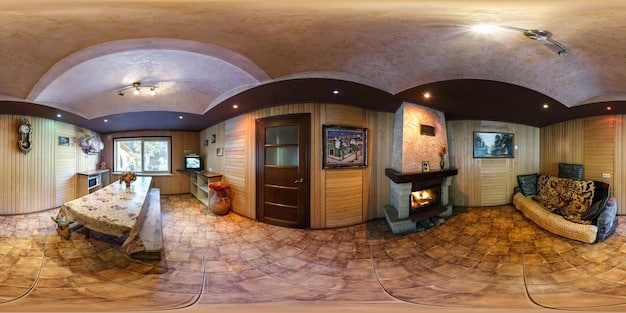Illuminate Your Home: A Guide to the Power of Lighting

The power of lighting in home decor extends beyond mere illumination, influencing mood, defining spaces, and accentuating architectural details; mastering its use can transform your living environment into a harmonious and inviting sanctuary.
Unlock the secrets to transforming your living space with the power of lighting: how to use light to enhance your home decor. Discover how strategic lighting choices can dramatically alter the ambiance and functionality of any room.
Understanding the Basics of Home Lighting
Lighting is more than just a functional necessity; it’s a critical element of interior design that profoundly affects how we perceive and experience a space. Understanding the different types of light and how they interact is the first step to creating a beautifully lit home.
From ambient lighting that sets the overall mood to task lighting that enhances productivity, each type plays a crucial role in defining a room’s character. Let’s delve into these lighting fundamentals.
Ambient Lighting: Setting the Mood
Ambient lighting, also known as general lighting, provides overall illumination to a room. It’s the foundational layer of light that ensures a space is adequately lit for basic visibility and creates the desired atmosphere.
Task Lighting: Enhancing Functionality
Task lighting focuses on specific activities, providing bright, direct light to make tasks easier and more comfortable. Good task lighting reduces eye strain and improves efficiency in functional areas.
- Layer your lighting: Combine ambient, task, and accent lighting for a dynamic and functional space.
- Consider bulb type: Choose LEDs for energy efficiency and a variety of color temperatures.
- Use dimmers: Control the intensity of your lighting to adjust the mood and save energy.
Understanding these basics allows you to make informed decisions when planning your home’s lighting. By strategically layering different types of light, you can create spaces that are both beautiful and functional, perfectly tailored to your needs and lifestyle.

The Impact of Color Temperature on Ambiance
The color temperature of your light bulbs can significantly impact the ambiance of your home. Measured in Kelvin (K), color temperature ranges from warm to cool, each creating a distinct mood. Choosing the right color temperature is essential for achieving the desired atmosphere in different areas of your home.
Warmer tones create a cozy, inviting atmosphere, while cooler tones offer a crisp, energizing feel. Consider how you want each room to feel and choose accordingly.
Warm Light: Creating a Cozy Atmosphere
Warm light, typically ranging from 2700K to 3000K, emits a soft, yellowish glow that creates a cozy and inviting atmosphere. This type of light is ideal for spaces where relaxation is key, such as bedrooms, living rooms, and dining areas.
Cool Light: Energizing Your Space
Cool light, ranging from 4000K to 5000K, emits a bright, white or bluish light that energizes and invigorates a space. It is excellent for task-oriented areas like kitchens, home offices, and bathrooms.
Selecting the right color temperature is crucial for setting the desired mood in each room. By understanding the impact of warm and cool lighting, you can transform your home into a welcoming and functional environment.
Choosing the Right Fixtures for Your Home
Selecting the right light fixtures is crucial for both aesthetics and functionality. The fixtures you choose should complement your home’s decor while providing the necessary illumination. From chandeliers to recessed lights, each type of fixture offers unique benefits.
Consider the style of your home, the purpose of the room, and the type of light you need when selecting fixtures. Let’s explore some popular options:
- Chandeliers: Ideal for adding a touch of elegance to dining rooms and entryways.
- Pendant Lights: Perfect for task lighting over kitchen islands or dining tables.
- Recessed Lights: Great for providing ambient lighting in any room while maintaining a clean look.
Floor Lamps: Adding Style and Functionality
Floor lamps are versatile fixtures that can enhance both the style and functionality of a room. They provide ambient or task lighting and come in a variety of designs to complement any decor.
Table Lamps: Versatile Accent Pieces
Table lamps are perfect for adding a layer of light to side tables, desks, or nightstands. They come in a variety of styles, from classic to contemporary, and can be used to create a cozy and inviting atmosphere.

Using Lighting to Highlight Architectural Features
Strategic lighting can accentuate your home’s architectural features, drawing attention to details that might otherwise go unnoticed. By using light to highlight textures, shapes, and focal points, you can add depth and dimension to your interiors.
Consider using spotlights, wall sconces, and accent lighting to showcase your home’s best assets. Here are some tips for highlighting architectural features:
Spotlighting: Focusing on Art and Details
Spotlights are perfect for highlighting artwork, sculptures, or architectural details. They provide focused light that draws the eye and creates a dramatic effect.
Wall Sconces: Adding Ambiance and Elegance
Wall sconces can add both ambiance and elegance to hallways, living rooms, and bedrooms. They provide soft, diffused light that enhances the overall atmosphere.
By strategically using lighting to highlight architectural features, you can create a visually appealing and sophisticated home. Experiment with different techniques to discover what works best for your space and style.
Smart Lighting: The Future of Home Illumination
Smart lighting systems offer unprecedented control and convenience, allowing you to automate and customize your home’s lighting. From adjusting brightness and color temperature to setting schedules and controlling lights remotely, smart lighting can transform your living experience.
Consider investing in smart bulbs, switches, and hubs to take advantage of these advanced features. Let’s explore the benefits of smart lighting:
- Energy Efficiency: Smart bulbs use less energy and can be programmed to turn off automatically.
- Customization: Adjust brightness, color temperature, and set schedules to suit your needs.
- Remote Control: Control your lights from anywhere using a smartphone or voice assistant.
Benefits of Smart Bulbs and Switches
Smart bulbs and switches offer a range of features that traditional lighting solutions lack. They can be easily integrated into your existing home setup and provide enhanced control over your lighting.
Integrating with Voice Assistants
Smart lighting systems can be integrated with voice assistants like Amazon Alexa, Google Assistant, and Apple Siri. This allows you to control your lights with voice commands, adding a new level of convenience to your home.
Smart lighting represents the future of home illumination, offering enhanced control, energy efficiency, and convenience. By investing in smart lighting, you can create a more comfortable and efficient living environment.
Practical Tips for Saving Energy with Lighting
Saving energy with lighting not only benefits the environment but also reduces your electricity bill. By making smart choices about light bulbs, fixtures, and usage habits, you can significantly lower your energy consumption.
Consider switching to LED bulbs, using dimmers, and turning off lights when not in use. Here are some practical tips for saving energy with lighting:
Switching to LED Bulbs
LED bulbs are significantly more energy-efficient than traditional incandescent bulbs. They use up to 75% less energy and last much longer, saving you money on electricity and replacement costs.
Using Dimmers to Control Brightness
Dimmers allow you to adjust the brightness of your lights, reducing energy consumption when full brightness is not needed. They also extend the lifespan of your bulbs.
By implementing these practical tips, you can save energy with lighting while maintaining a well-lit and comfortable home. Small changes in your lighting habits can have a big impact on your energy bill and the environment.
| Key Point | Brief Description |
|---|---|
| 💡 Layer Lighting | Combine ambient, task, and accent lights. |
| 🌡️ Color Temperature | Warm light for cozy, cool for energetic spaces. |
| 💡 Fixture Choice | Select fixtures to match style and function. |
| 🔆 Smart Lighting | Use smart bulbs and voice control for convenience. |
Frequently Asked Questions
▼
Ambient lighting, also known as general lighting, provides overall illumination to a room. It’s important because it ensures the space is adequately lit for basic visibility and creates a welcoming atmosphere.
▼
Color temperature significantly impacts the mood; warm light (2700K-3000K) creates a cozy atmosphere, while cool light (4000K-5000K) offers an energizing feel. Choose based on the room’s purpose.
▼
LED bulbs are far more energy-efficient than traditional bulbs, using up to 75% less energy. They also last significantly longer, reducing replacement costs and energy bills.
▼
Use spotlights to focus on artwork or details and wall sconces to add ambiance. Strategic placement draws the eye and enhances textures, shapes, and focal points, adding depth.
▼
Smart lighting systems allow automation and customization of your home’s lighting. Benefits include energy efficiency, remote control, and adjustable brightness/color temperature for a personalized living experience.
Conclusion
Mastering the power of lighting is essential for enhancing your home decor and creating a comfortable, functional, and visually appealing living space. By understanding the basics of lighting, choosing the right fixtures, and implementing energy-saving tips, you can transform your home into a welcoming sanctuary that reflects your personal style.





